 Research Article
Research Article
Study on the Impregnation of Archaeological Wood with an Automated Equipment
Zhang shaozhi1, Li Yang1, Liu Dongpo2, Zheng Youming2 and Lu Heng2*
1Refrigeration and Cryogenic Engineering Institute, China
2Museum of Zhejiang Province, China
Lu Heng, Museum of Zhejiang Province, Hangzhou 330106, China.
Received Date: March 12, 2019; Published Date: March 22, 2019
Abstract
Heated impregnation is a routine dealing operation for unearthed archaeological wooden artifacts. Most of the water can be replaced and the voids can be filled with stabilizing chemical agents by putting the artifacts in the solutions at elevated temperatures. The impregnation process usually lasts for days, even for months. Traditionally the concentration and temperature of the soaking solution are regulated manually, which leads to high labor intensity and low efficiency of impregnation. In this paper special equipment was developed for the heated impregnation of archaeological wood with polyethylene glycol (PEG). The temperature of the solution was controlled, and the weight was monitored to give hints for changing the PEG concentration. The solution in the soaking tank was periodically circulated to enhance the mass transfer. Numerical simulations were carried out for the flow in the tank and the diffusion of PEG in the artifact. Compared with static soaking, the periodical stirring could effectively reduce the impregnation time. The equipment was put into use for handling several archaeological wooden artifacts with PEG4000. Good results had been obtained. The shapes and appearances of the artifacts were well kept.
Keywords: Archaeological wood; Impregnation; Numerical simulation; Mass transfer; Polyethylene glycol
Introduction
Unearthed archaeological wooden artifacts in southern China often contain a large amount of water. In most cases the artifacts are more or less decayed. To preserve them, most of the water has to be removed, and the structures must be enhanced with consolidants. Many materials have been applied with certain extent of success. Chen and Cui used sucrose as the primary consolidant for the conservation of painted woodwork [1]. The China Institute of cultural relics replaced the water in bamboo slips with alcohol and ether and consolidated them with mastic gum [2]. PEG is a common material for waterlogged wood conservation. Many tests and practices have been reported about its applications. Hocker, et al. [3] shared their fifty years’ experience of using PEG for conservation, PEG was thought to be reliable, repeatable, economical and convenient provided precautions were taken. Hoffmann found that the PEG-impregnated archaeological oak planks could be bent safely and quickly to greater deflections than would be necessary to re-shape the hull [4]. Morlat-Thérias, et al. carried out experiments on the durability of PEG and other polymers used in consolidation of wet archaeological wooden objects [5]. Babiński screened the PEG consolidate for the pretreatment of archaeological pine wood based on dimensional stability and hygroscopicity of the freeze-dried wood samples [6]. One author of this paper, Liu used PEG2000 as bulking and consolidating agent to treat an archaeological camphor tree excavated at the Homutu Ruins [7].
Although many consolidates have been found and used but searching for ideal consolidates is still on the way [8]. Considering the conservation ethics claim that every material used must be removable, the consolidates are usually dissolved in solutions before they diffuse or immigrate into the artifacts. There are a few researches focusing on the impregnation or soaking process. Kang et al investigated the penetration of PEG4000 and sucrose in four kinds of archaeological waterlogged woods which had been degraded to various degrees and quantified the deformations of the specimens [9]. The authors studied the mass transfer process of PEG impregnation with fragments, the influential factors including sample basic density, fiber orientation, PEG molecule weight, PEG solution concentration and temperature were investigated [10].
During recent years infrastructures and buildings are being built at a large scale in China. Many archaeological artifacts were inevitably unearthed, including wooden artifacts. To conserve these artifacts safely becomes a heavy task due to limited staffs and resources. In Museum of Zhejiang Province, we used to impregnate wooden artifacts with static solutions whose concentrations were raised by natural evaporation. The handling of artifacts took a long time. In order to increase the efficiency of impregnation, special equipment was developed by the museum and Zhejiang University.
Impregnation equipment
As shown in Figure 1, the impregnation equipment mainly consisted of three tanks, one holding case, one chain block, two circulation pumps, some sensors and one electrical cabinet. The sizes of the water tank, solution tank and PEG were 280×129×100cm, 245×100×70cm, 500×325×200mm respectively. PEG4000 made in Korea was used in the tests. Figure 2 shows the photo of the installed equipment. The woods were held in the holding case as shown in Figure 3. The holding case was moved up and down with the chain block. A weight sensor was installed on the holding rope. The PEG solution in the solution tank was circulated periodically with a pump. The solution temperature was indirectly controlled with the temperature of the water bath, which was sensed by PT100 installed on the water pipeline. The PEG concentration in the solution tank could be changed by addition of pure PEG from the PEG tank. The circulation of the solution dispersed the pure PEG. In order to avoid the damage of washing on the wooden objects, the solution velocity in the tank was designed to be less than 0.3m/s, on the other hand, the time ratio of circulation was limited not higher than 10%. The impregnation process was monitored by the weight sensor. For each stage of the process, the change of the weight value tended to drop gradually, to be almost zero finally. The above mentioned monitoring and control were realized with a S7-200 programmable logical controller (PLC).
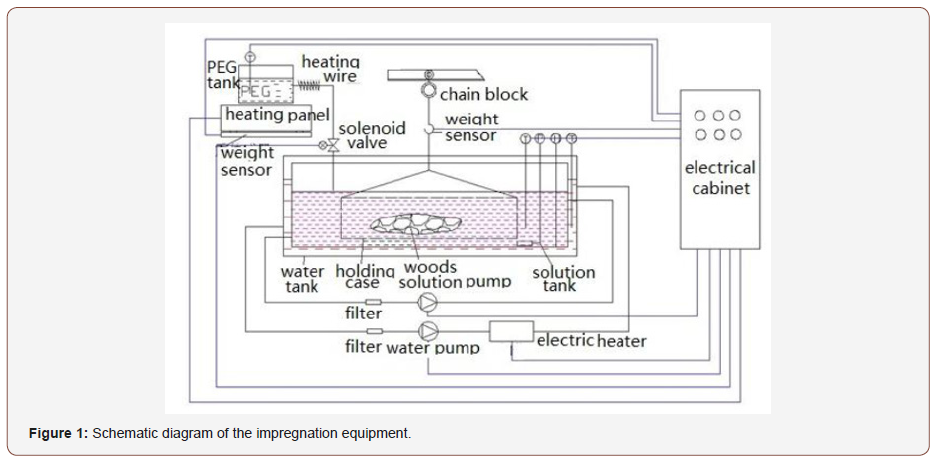
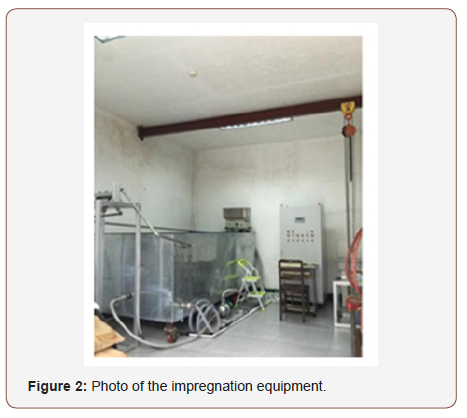
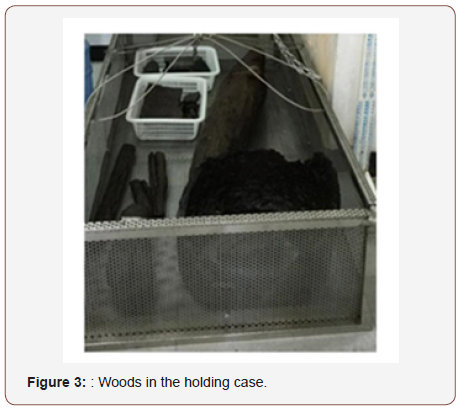
Modeling of the impregnation process
For the impregnation process taken place in the new equipment, only the diffusion of PEG in the woods was considered. The diffusion coefficients of PEG4000 in woods were taken from our previous study as shown in Figure 4 [10]. The diffusion coefficients of PEG4000 in bulk aqueous solution were estimated with literature data, Flory-Huggins theory and free volume theory [11-13]. Figure 5 shows the dependence of diffusion coefficient on mass fraction of PEG4000 and temperature. Compared with the diffusion coefficient of PEG4000 in woods, the diffusion coefficient of PEG4000 in bulk solution is 2~3 orders of magnitude higher. The PEG solution in the solution tank was stirred periodically, thus it was assumed homogeneous. The mass transfer resistance on the soaking solution side was negligible compared with the mass transfer resistance in the wood. Constant concentration boundary was assumed on the surface of the object. For wooden objects with regular shape, e.g. flat plate, cylinder, the temporal and spatial concentration distribution and the average concentration in the object could be easily calculated with existed formulas [14]. For wooden objects with irregular shape, the modeling and simulation were done with COMSOL.
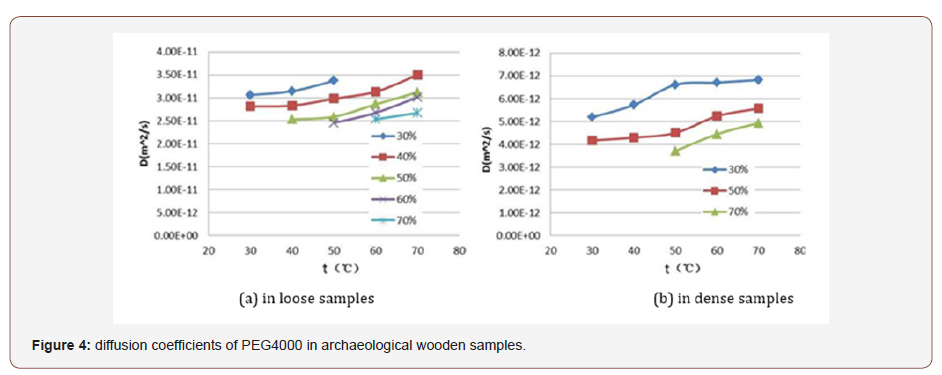
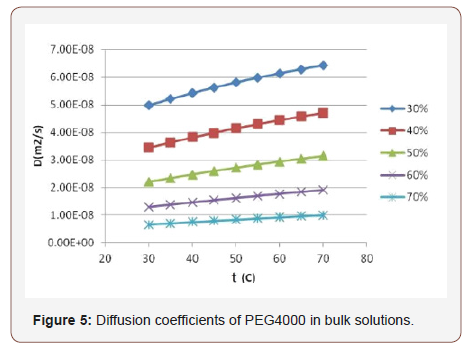
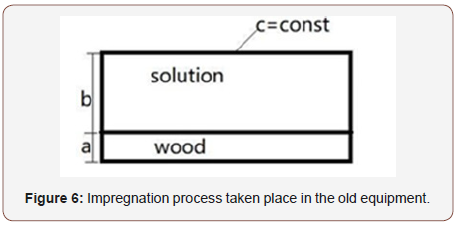
The impregnation process taken place in the old equipment was also calculated for the aim of comparison. Since the elevation of PEG concentration was realized by evaporation, constant concentration boundary was assumed on the surface of the solution, as shown in Figure 6. The viscosities of PEG4000 solutions were high, thus the convection in the solution was neglected. Only diffusion was considered in the simulation.
Results and Discussion
The impregnation time might be estimated with the above
models. Considering an impregnation protocol with three steps:
1) 40 °C, 30% PEG; 2) 50 °C, 40% PEG; 3) 60 °C, 50%, each step
ended when ( −C0 ) / (C1 −C0 ) reached 80%, where
−C0 ) / (C1 −C0 ) reached 80%, where  was the
average PEG concentration in the wood, C0 was the initial PEG
concentration in the wood, C1 was the PEG concentration of the
soaking solution. Figure 7 shows the time needed for each step
for four cases: loose plate, loose cylinder, dense plate, and dense
cylinder. As the thickness of the plate or the radius of the cylinder
increases, the times needed for three steps increase almost at the
same magnitude. As a brief approximation, the time increases
linearly with the thickness or the radius. For artifacts with complex
shape, numerical simulation was employed as a tool to estimate
the impregnation time, and to justify the process. As an example,
Figure 8 (a) ~(d) show the concentration distributions at different
time nodes for one protocol A: 1) 30 °C, 20wt% PEG, lasting for
two days; 2) 30 °C, 30wt% PEG, lasting for three days; 3) 40 °C,
40wt% PEG, lasting for two days; 4) 50 °C, 50wt% PEG, lasting
for 23 days. Figure 9 shows the average concentration change
during the impregnation process. After 30 days of soaking the
average PEG concentration in the wood reaches a high level, but the concentration gradient is also high which may cause excessive
stress and crack [9]. During most of the impregnation process, the
concentration difference between the maximum and the minimum
is greater than 30wt%. To reduce the risk of crack, another protocol
B was simulated: 1) 30 °C, 20wt% PEG, lasting for 25 days; 2) 30 °C,
30wt% PEG, lasting for 25 days; 3) 40 °C, 40wt% PEG, lasting for 25
days; 4) 50 °C, 50wt% PEG, lasting for 25days. Figure 10 (a)~(d)
show the concentration distributions at different time nodes for
this protocol. After increasing the dealing time, the concentration
difference between the maximum and the minimum could be kept
under 20wt%.
was the
average PEG concentration in the wood, C0 was the initial PEG
concentration in the wood, C1 was the PEG concentration of the
soaking solution. Figure 7 shows the time needed for each step
for four cases: loose plate, loose cylinder, dense plate, and dense
cylinder. As the thickness of the plate or the radius of the cylinder
increases, the times needed for three steps increase almost at the
same magnitude. As a brief approximation, the time increases
linearly with the thickness or the radius. For artifacts with complex
shape, numerical simulation was employed as a tool to estimate
the impregnation time, and to justify the process. As an example,
Figure 8 (a) ~(d) show the concentration distributions at different
time nodes for one protocol A: 1) 30 °C, 20wt% PEG, lasting for
two days; 2) 30 °C, 30wt% PEG, lasting for three days; 3) 40 °C,
40wt% PEG, lasting for two days; 4) 50 °C, 50wt% PEG, lasting
for 23 days. Figure 9 shows the average concentration change
during the impregnation process. After 30 days of soaking the
average PEG concentration in the wood reaches a high level, but the concentration gradient is also high which may cause excessive
stress and crack [9]. During most of the impregnation process, the
concentration difference between the maximum and the minimum
is greater than 30wt%. To reduce the risk of crack, another protocol
B was simulated: 1) 30 °C, 20wt% PEG, lasting for 25 days; 2) 30 °C,
30wt% PEG, lasting for 25 days; 3) 40 °C, 40wt% PEG, lasting for 25
days; 4) 50 °C, 50wt% PEG, lasting for 25days. Figure 10 (a)~(d)
show the concentration distributions at different time nodes for
this protocol. After increasing the dealing time, the concentration
difference between the maximum and the minimum could be kept
under 20wt%.
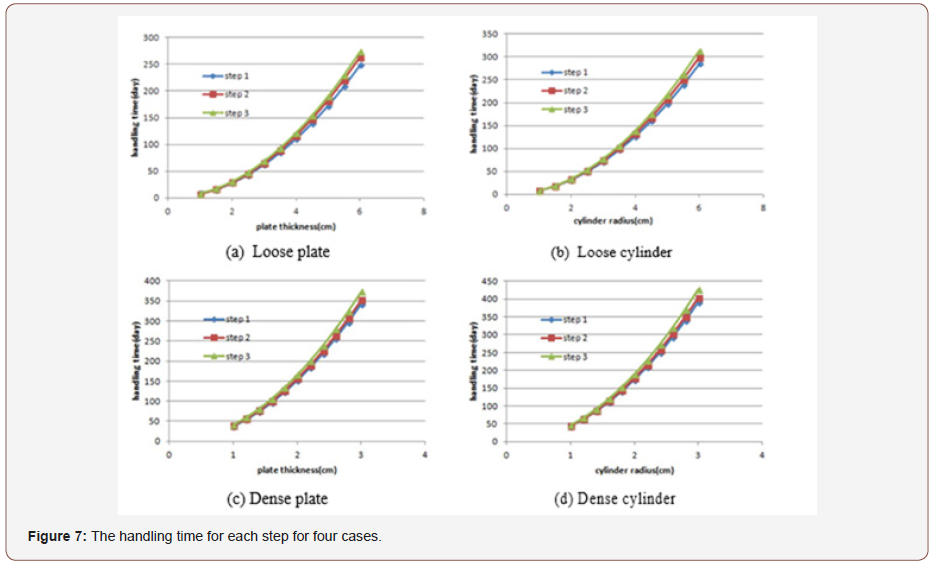
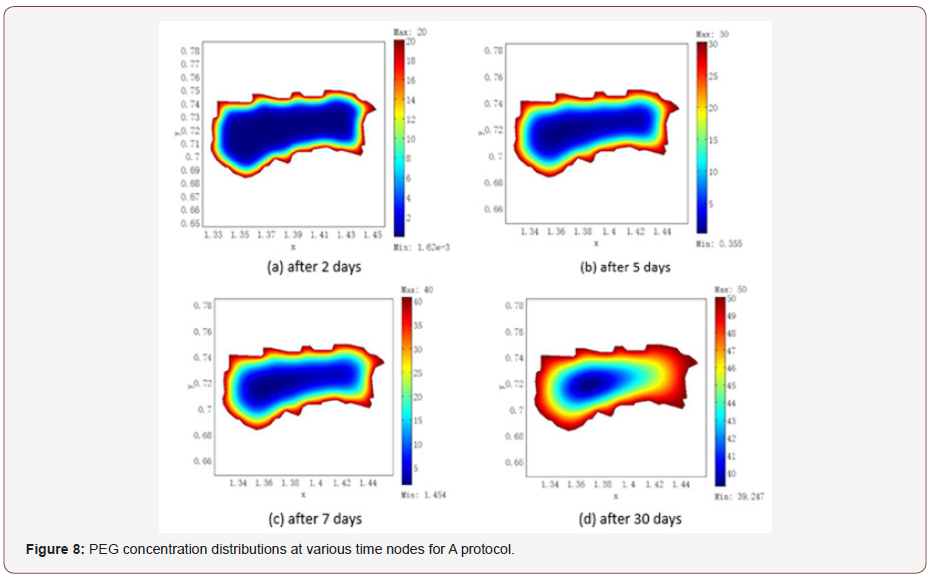
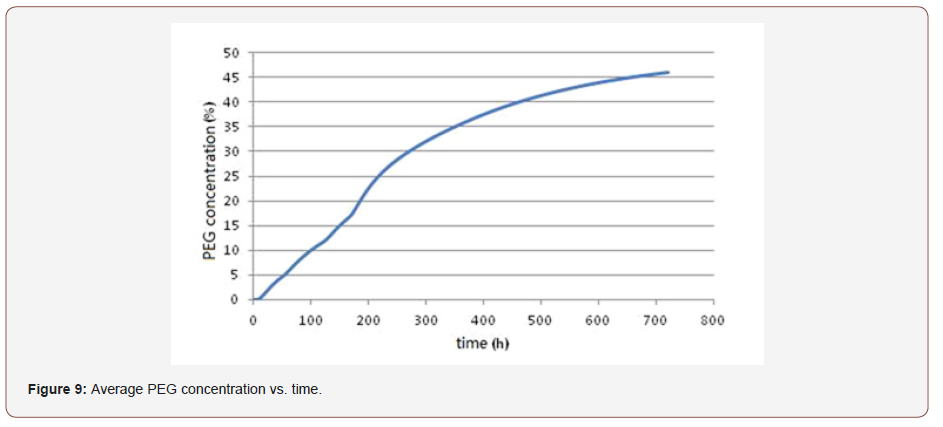
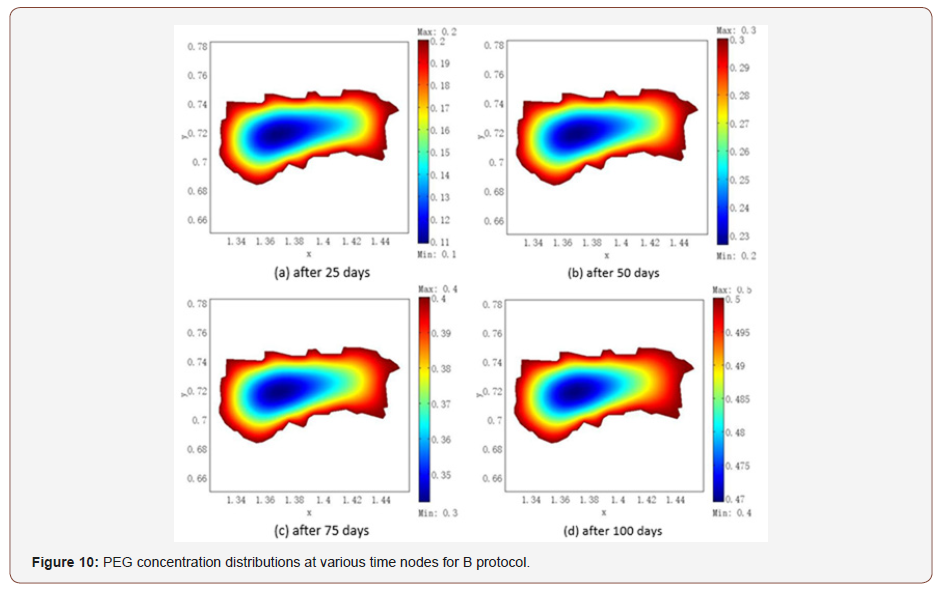
To demonstrate the benefit that was brought by the new equipment, a brief calculation was made for the impregnation of a planar wooden sample with thickness of 50mm. In traditional equipment, the solution depth was assumed to be 100mm, e.g. a=50mm, b=100 in Figure 6. The impregnation protocol was as follows: 1) 30 °C, 20wt% PEG, lasting for five days; 2) 30℃, 30wt% PEG, lasting for five days; 3) 40 °C, 40wt% PEG, lasting for five days; 4) 50 °C, 50wt% PEG, lasting for 15 days. After 30 days of impregnation, the average PEG concentrations in the sample were respectively 17.6wt% and 19.8wt% for the traditional equipment and the new one. The impregnation time could be reduced by ~10%. If ratio of the solution depth to sample thickness increased, the superiority of the new equipment would be more obvious. The other advantage of the new equipment was its weighing capacity, which could help to judge the end of impregnation. Figure 11 shows the wooden artifacts before and after the impregnation. These artifacts were unearthed at Guangfulin, Shanghai. It can be noted that the wood shapes and grains were well kept after 120 days of impregnation. The final concentration of the bulk solution was about 40%. The success operation of the new equipment was verified.
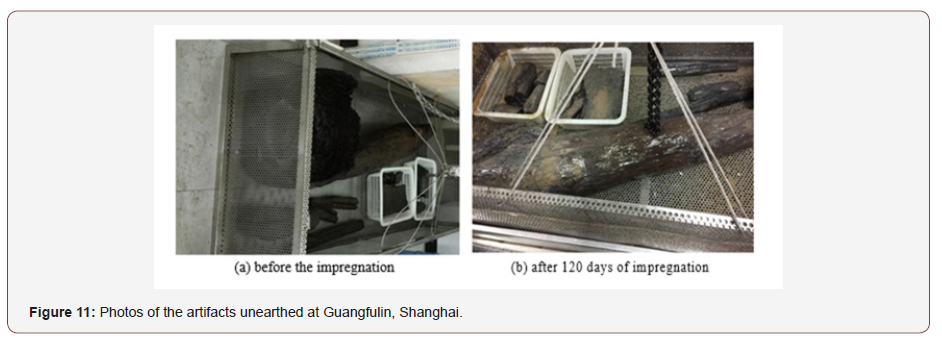
Conclusion
The conservation of unearthed artifacts remains a heavy task in current China. An impregnation equipment with more automation measures was developed to handle waterlogged woods. Appropriate stirring was adopted to accelerate the impregnation process. The modeling of the mass transfer involved could make the impregnation protocol more reasonable. With the new equipment good results were obtained in the dealing of unearthed artifacts.
Acknowledgement
This work was supported by archaeological artifact protection technology project of Zhejiang Province (NO2017008).
Conflict of Interests
No Conflict of Interest.
References
- JL Chen, ZH Cui (1994) Consolidation with sucrose: study on dehydration and fixation of the waterlogged painted woodworks unearthed from Changtaiguan, Xinyang, Henan, Sciences of Conservation and Archaeology 2 :1-6.
- (2004) The China Institute of cultural relics, Enhancement of unearthed waterlogged bamboo slips with alcohol/ether soaking and gum mastic permeation, China Cultural Heritage (3): 61-6.
- Hocker E, Almkvist G, Sahlstedt M (2012) The vasa experience with polyethylene glycol: A conservator’s perspective. Journal of Cultural Heritage 13(3): S175-S182.
- Hoffmann P (2010) On the long-term visco-elastic behaviour of polyethylene glycol (PEG) impregnated archaeological oak wood. Holzforschung 64(6): 725-728.
- Morlat Thérias S, Gardette J, Chaumat G, Tran QK, Dumarcay S, et al. (2007) Durability of water-soluble polymers used in consolidation of wet archaeological wooden objects. [Durabilité de polymères hydrosolubles utilisé pour la consolidation des objets archéologiques en bois humide] Actualite Chimique (312-313): 93-97.
- Babiński L (2011) Investigations on pre-treatment prior to freeze-drying of archaeological pine wood with abnormal shrinkage anisotropy. Journal of Archaeological Science 38(7): 1709-1715.
- Liu DP (2015) Study on the drying characteristics of PEG-treated archaeological camphor tree excavated at the Homutu Ruins, Sciences of Conservation and Archaeology 27(2) :13-18.
- M Christensen, H Kutzke, FK Hansen (2012) New materials used for the consolidation of archaeological wood-past attempts, present struggles, and future requirements. Journal of Cultural Heritage 13(3): S183-S190.
- Kang AK, Sakai H, Imadu S, Imamura Y, Park SJ (1997) Diffusion of polyethylene glycol # 4000 and sucrose into archaeological waterlogged woods. Mokuzai Gakkaishi/Journal of the Japan Wood Research Society 43(6): 504-512.
- Zhang SZ, Jiang Q, Liu DP, Zheng YM, Lu H, Chen GM (2016) Study on the impact factors of PEG impregnation of wooden archaeological artifacts, China Cultural Heritage Scientific Research 28(1): 63-67.
- JG Albright, L Paduano, R Sartorio (2001) Multicomponent diffusion in systems containing molecules of different size. 1. Mutual diffusion in the ternary system poly (ethylene glycol) 2000+ poly (ethylene glycol) 200+ water, Journal of Chemical & Engineering Data 46(5): 1283-1291.
- JM Zielinski, JL Duda (1992) Predicting polymer/solvent diffusion coefficients using free-volume theory, AIChE Journal 38(3): 405-415.
- JL Duda, JS Vrentas, ST Ju, HT Liu (1982) Prediction of diffusion coefficients for polymer‐solvent systems, AIChE Journal 28(2): 279-285.
- J Crank (1975) The Mathematics of Diffusion(second edition), Clarendon Press, Oxford, USA, p. 47.
-
Zhang shaozhi, Li Yang, Liu Dongpo, Zheng Youming, Lu Heng. Study on the Impregnation of Archaeological Wood with an Automated Equipment. Glob J Eng Sci. 1(5): 2019. GJES.MS.ID.000525.
-
Archaeological wood, Impregnation, Numerical simulation, Mass transfer, Polyethylene glycol, Flory-Huggins, Homogeneous, Loose plate, Loose cylinder, Dense plate, Dense cylinder
-

This work is licensed under a Creative Commons Attribution-NonCommercial 4.0 International License.






